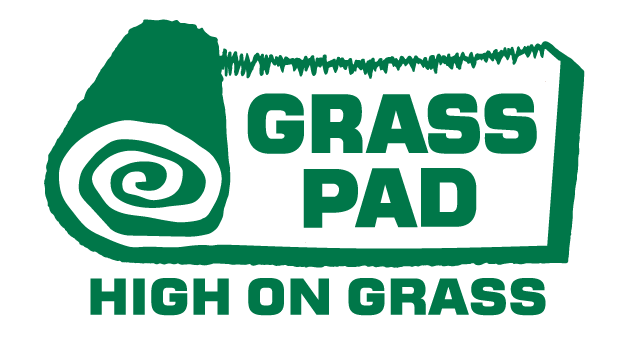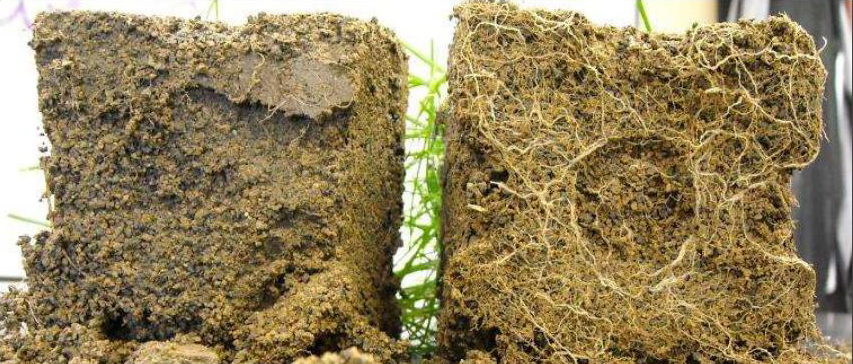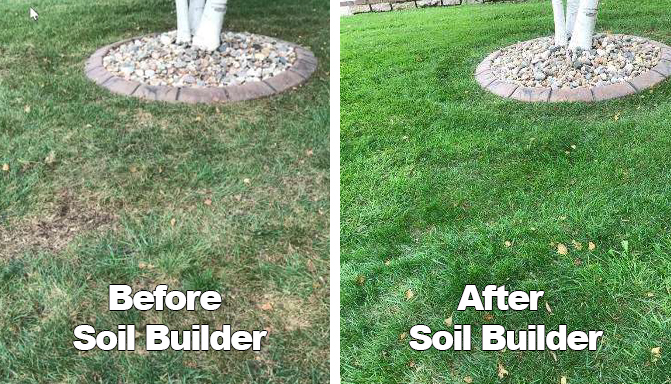SOIL BUILDER
Designed to help reduce compaction and promote root growth.
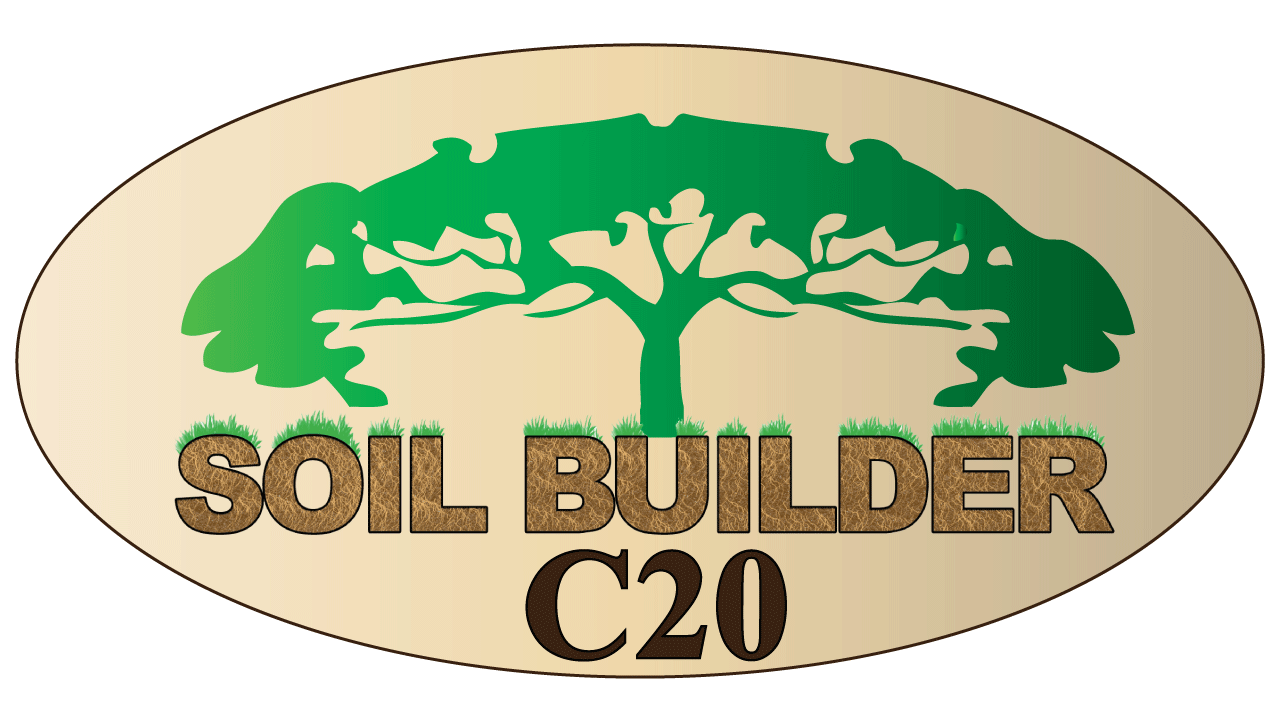
Reduce Soil Compaction with Soil Builder
Soil Builder is a natural, carbon-based food source for microbes in the soil, which promotes soil aeration and healthy plant growth. By feeding and energizing the microbes living in the soil, the increased physiological actions of the native soil microbes naturally reduce the soil’s bulk density, breaking up the hard clay and reducing compaction, improving the growing characteristics of the soil. Soil Builder is perfect for areas where it’s challenging to get a mechanical aerator or when aeration and verticutting are not recommended, such as springtime. It also works well for chlorosis trees and in flower beds with compacted soil.
Mechanical aeration (left) leaves soil plugs on the lawn and requires a large machine. Non-mechanical aeration (using Soil Builder) only requires a rotary spreader and achieves the same result (results shown on right).
Compacted soil (left) compared to soil enhanced by Soil Builder (right). Notice the increase in root structures and decreased compaction of the soil.
Improve Compacted Soils
Soil compaction occurs when the soil is packed together, reducing the amount of space between the soil particles. This leads to poor water infiltration and drainage, and makes it difficult for roots to grow into the soil. Important soil life, like earthworms, microbial life and bacteria all struggle to survive in densely packed soil. Soil compaction is a common problem in mid-western states with our heavy clay soils, making it more difficult to grow grass, as well as causing things like chlorosis is trees like the Pin Oak. Heavy machinery used to build our houses is another reason for compacted soils in our yard, so new developments can struggle with this issue.
Lawn Aeration without Machines
Soil Builder is the perfect product for aerating lawns when you can’t use a mechanical aerator, such as root dense areas beneath trees, areas you can’t reach with a mechanical aerator and flower beds. The granular formula is designed to feed the microbes in the soil and use their life cycle to add space to the soil and make nutrients available for plants. It’s also easier than renting a large machine and dragging it all over your lawn!
Spring Lawn Aeration with Soil Builder
Aerating or verticutting your lawn during the spring can cause you to bring weed seeds to the surface of the soil before the warm growing season. This can result in your new grass competing with weeds instead of growing full and thick. If you are spring seeding, we recommend using Soil Builder as a way to aerate your grass in the spring, as there is no machine that disturbs the soil.
Soil Builder C20 improves the soil for enhanced root growth, leading to healthier, fuller grass. See the application rates below for turf to see what spreader settings you should use.
Seeding Lawns with C20 Soil Builder
Soil Builder decompresses the soil without disturbing the plants, making it an excellent companion to fall lawn renovation. The increase in microbial activity after applying Soil Builder increases the permeability of the soils for optimum root establishment. Nutrients released by the soil microbes from the existing soil and increased porosity will encourage rapid root development, supporting seedling survival on compacted areas in home lawns, golf courses, and sports fields.
Improved Soil in Flower Beds
Growing gardens under trees can be difficult. Plants are competing with the tree for resources and soil compaction adds to these difficulties by making it difficult for roots to grow in that area. Aerating with a machine under a tree can be difficult or impossible due to the roots in the area. Soil Builder is the perfect solution for enhancing root growth and improving compacted soil under trees.
By feeding the microbes already in the soil, we promote increased aeration of the soil which allows more space for roots to grow, increases water movement in the soil, and increases chlorophyll production. You can apply Soil Builder any time during the growing season, and the all-natural formula makes it an eco-friendly product. Simply follow the application rates on the chart below.
Fix Tree Chlorosis with Soil Builder
Tree Chlorosis is the yellowing of leaves on a tree and is caused by a variety of factors including soil compaction, lack of nutrients, and poor drainage. Common trees to have chlorosis in the mid-west area include pin oaks, red maple, white oaks and more. If you have one of these trees and the leaves are yellow instead of a lush green, you might be dealing with chlorosis. A common nutrient deficiency is iron. If you have added iron to the soil and haven’t seen any improvement, it’s time to use Soil Builder to help the tree absorb the available nutrients.
There are nutrients available in most soils, but sometimes plants have a hard time absorbing these nutrients because they’re not available. Soil Builder feeds the microbes in the soil which in turn make the nutrients available for the trees to absorb.This leads to increased nutrients in the tree, such as iron, which can help prevent and fix chlorosis. Check our application rates for chlorotic trees.
Application Instructions for Soil Builder
Application Rates for Trees - Soil Builder
-
- Measure a ring around the tree up to 50% of the tree canopy diameter of the tree but no more than five
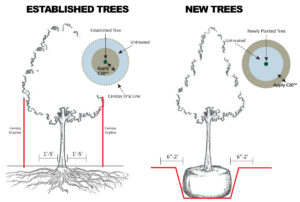 feet out from the base of the tree.
feet out from the base of the tree. - Clear the marked area using a rake or shovel. Remove all plastic or fabric weed barriers, decorative rock or sod. Do not cover the Soil Builder fabric or plastic weed barriers.
- Apply the recommended amount of Soil Builder on the chart below to the surface area of the ring. Be sure that the Soil Builder is in contact with the soil surface.
- Rake the Soil Builder to level.
- Cover the treated area with wood mulch to a depth of 2-3 inches or with soil to a depth of 1 inch.
- Irrigate the treatment area after application to initiate microbial activity.
- Measure a ring around the tree up to 50% of the tree canopy diameter of the tree but no more than five
Applications Rates for Flower and Vegetable Gardens - Soil Builder
To apply Soil Builder to established flower beds, you must first remove the weed barrier or mulch from the bed so that you can apply directly to bare soil. You can then apply Soil Builder to the soil with a broadcast spreader or directly to the base of the plant. Then rake into the top 1 or 2 inches of soil. See the chart below for the rate of application:
Broadcast Rate:
- 2 lbs. of Soil Builder per 100 sq. ft.
- 20 lbs. of Soil Builder per 1,000 sq. ft.
Base of Plant Rate:
- 5 Tbsp. of Soil Builder per 1 sq. ft.
- 1 Tbsp. of Soil Builder per 4’ pot
Application Rates for Turf - Soil Builder
Season Maintenance Rate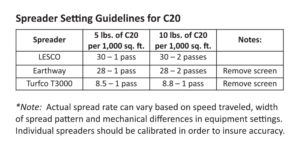
10 lbs. per 1,000 sq. ft.
Spring or fall application
- Increase microbial activity and reduce thatch
- Enhance root development
- Ideal for seeding in place of mechanical aeration
Lawn Rejuvenation Rate
10-20 lbs. per 1,000 sq. ft.
- Soil building
- Reduce bulk density
- Loosen soil for root penetration and access to air, water and nutrients
- Use in place of spring aeration where pre-emergents are used
- Ideal for fall over-seeding
- Reduce thatch
New Sod Rate
10 lbs. per 1,000 sq. ft.
- Spread Soil Builder on soil before laying sod
- Increases the turf-rooting environment
How does Soil Builder Work?
Soil Builder provides a carbon food source for the microbes that are already in your soil. This food helps those microbes grow and reproduce, increasing the aeration of the soil and making nutrients available for plants in the area. Soil Builder helps promote a thriving living environment that promotes root development, nutrient uptake, and overall plant health.
How Long Does Soil Builder Take to Work?
Soil Builder is food for the microbial life already in your soil. As we feed these microorganisms, they go to work on the soil.
- Restructures soil within 3-6 weeks
- Reduces bulk density within 3-6 weeks
- Activity in the soil is visible within 1-2 weeks
- Enhanced root development is visible within 2-6 weeks
- Foliar development is visible within 1-2 months
